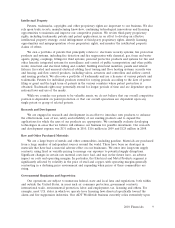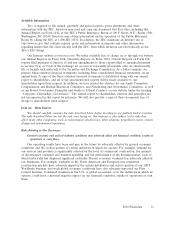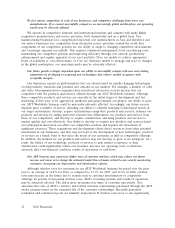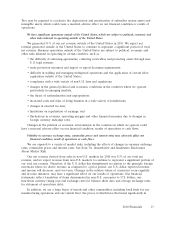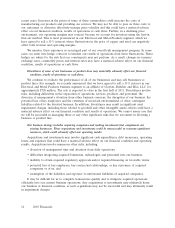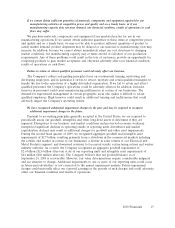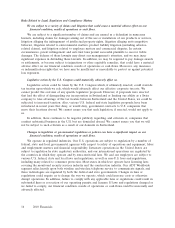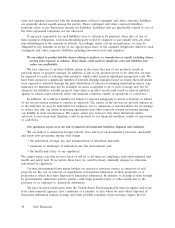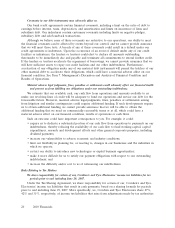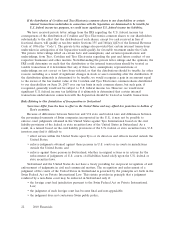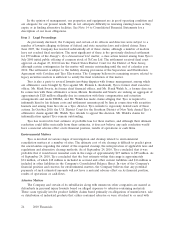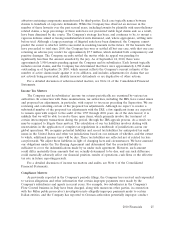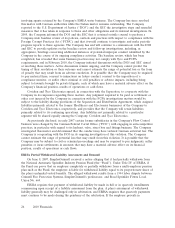ADT 2010 Annual Report Download - page 107
Download and view the complete annual report
Please find page 107 of the 2010 ADT annual report below. You can navigate through the pages in the report by either clicking on the pages listed below, or by using the keyword search tool below to find specific information within the annual report.reimburse the government or otherwise pay for the cost of cleanup of those sites and/or for natural
resource damages. We have projects underway at a number of current and former manufacturing
facilities to investigate and remediate environmental contamination resulting from past operations.
These projects relate to a variety of activities, including:
• solvent, metal and other hazardous substance contamination cleanup; and
• oil spill equipment upgrades and replacement.
These projects involve both remediation expenses and capital improvements. In addition, we
remain responsible for certain environmental issues at manufacturing locations previously sold by us.
The ultimate cost of cleanup at disposal sites and manufacturing facilities is difficult to predict
given uncertainties regarding the extent of the required cleanup, the interpretation of applicable laws
and regulations and alternative cleanup methods. Based upon our experience, current information
regarding known contingencies and applicable laws, we concluded that it is probable that we would
incur remedial costs of approximately $27 million to $85 million as of September 24, 2010. As of
September 24, 2010, we concluded that the best estimate within this range is approximately $34 million,
of which $18 million is included in accrued and other current liabilities and $16 million is included in
other liabilities in the Consolidated Balance Sheets as of September 24, 2010. Environmental laws are
complex, change frequently and have tended to become more stringent over time. While we have
budgeted for future capital and operating expenditures to maintain compliance with such laws, we
cannot provide assurance that our costs of complying with current or future environmental protection
and health and safety laws, or our liabilities arising from past or future releases of, or exposures to,
hazardous substances will not exceed our estimates or materially adversely affect our financial
condition, results of operations or cash flows. We may also be subject to material liabilities for
additional environmental claims for personal injury or cleanup in the future based on our past, present
or future business activities or for existing environmental conditions of which we are not presently
aware.
Risks Related to Our Liquidity
Disruptions in the financial markets could have adverse effects on us, our customers and our suppliers,
as access to liquidity may be negatively impacted by disruptions in the credit markets, leading to
increased funding costs or unavailability of credit.
In the normal course of our business, we may access credit markets for general corporate
purposes, which may include repayment of indebtedness, acquisitions, additions to working capital,
repurchase of common shares, capital expenditures and investments in the Company’s subsidiaries.
Although we believe we have sufficient liquidity to meet our foreseeable needs, our access to and the
cost of capital could be negatively impacted by disruptions in the credit markets. In 2009 and 2010,
credit markets experienced significant dislocations and liquidity disruptions, and similar disruptions in
the credit markets could make financing terms for borrowers unattractive or unavailable. These factors
may make it more difficult or expensive for us to access credit markets if the need arises. In addition,
these factors may make it more difficult for our suppliers to meet demand for their products or for
prospective customers to commence new projects, as customers and suppliers may experience increased
costs of debt financing or difficulties in obtaining debt financing. Disruptions in the financial markets
have had adverse effects on other areas of the economy and have led to a slow down in general
economic activity that may continue to adversely affect our businesses. These disruptions may have
other unknown adverse affects. Based on these conditions, our profitability and our ability to execute
our business strategy may be adversely affected.
2010 Financials 19


